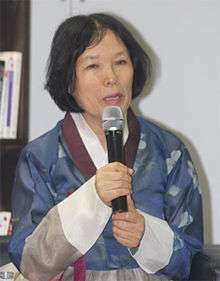So Young-en
| So Young-en | |
|---|---|
 At SIBF 2014 | |
| Born | May 18, 1943 |
| Language | Korean |
| Nationality | South Korean |
| Korean name | |
| Hangul | 서영은 |
| Hanja | 徐永恩 |
| Revised Romanization | Seo Yeong-eun |
| McCune–Reischauer | Sŏ Yŏngŭn |
| Childhood name | |
| Hangul | 서보영 |
| Hanja | 徐保永 |
| Revised Romanization | Seo Boyeong |
| McCune–Reischauer | Sŏ Poyŏng |
So Young-en (서영은; born May 18, 1943) is a South Korean writer.[1]
Life
Born in Gangneung, Gangwon-do, So graduated from Gangneung Teacher Training School in 1961 and entered Konkuk University in 1963 to study English Language and Literature. However she left the university in 1965.[2] In 1968, her short story, "Bridge" (Gyo) was accepted for publication by World of Thoughts (Sasanggye) and the following year, "I and 'I'" (Nawa 'na') was published in Monthly Literature (Wolgan munhak). She also worked as an editor for Literature and Thought (Munhaksasang) and reported for Korean Literature (Hanguk munhak), under the editorship of Lee Mungu.[3]
Work
So's works feature a deep-seated nihilism and a sense of alienation as experienced by 'pure souls'. Often her characters are ordinary people who long for and even strive towards spiritually elevated existence while struggling with the meaninglessness of their tedious life. In "How to Cross a Desert" (Samageul geonneoganeun beop, 1975), the psychology of a man who endeavors to overcome the painful memories of the Vietnam War and return to normal life is expressed through his relationship with another man who lives in his own fantasy world.[4] In “The Golden Feather” (Hwanggeum gitteol, 1980), an undistinguished middle-aged poet realizes that his lifelong effort to preserve the purity of his literary zeal has amounted to nothing. Facing his mediocre life, he sees that the ideal he once sought can never be his. At the same time, he is reluctant to embrace the only possible choice left to him to throw away the now useless 'golden feather' and compromise with reality.[5] The opposition between unattainable ideal and undesirable reality is also the topic of "Gwansa People" (Gwansa saramdeul), which shows the ways in which the rules and habits of everyday life can taint the purity of one’s soul. By contrast, "Tagger, Tagger" (Sullaeya sullaeya, 1980) features a woman who successfully escapes the tyranny of deadening routine. In "Dear Distant Love" (Meon geudae, 1983), perhaps her best known work, spiritual beauty and perfection is embodied in a seemingly pitiful woman who silently endures and rises above the oppressive and unjust reality to achieve inner peace. The golden feather in "The Golden Feather", camel in "Dear Distant Love" and butterfly in "Gwansa People" all symbolize positive affirmation of nihilism elevated to the level of absolute spiritual purity.[6]
Works in translation
- A Walk in the Mountains
Works in Korean (partial)
- Short story collections
- How To Cross a Desert (1977)
- A Festival of Flesh and Bones (Sal gwa ppyeoui chukje, 1978)
- Tagger, Tagger (1981)
- Golden Feather (Hwanggeum gitteol, 1984)
- The End of the River (Gangmurui kkeut, 1984)
- A Window with a Ladder (Sadariga noin chang, 1990)
- From Road to Oceanside (Gireseo badatkaro, 1992)
- From Dream Road to Dream Road (Kkumgireseo kkeumgillo, 1995).
Awards
- Yi Sang Literature Prize for her short story "Dear Distant Love" (1983)
- Yeonam Literary Prize for A Window with a Ladder (1990)
References
- ↑ "서영은" biographical PDF available at LTI Korea Library or online at: http://klti.or.kr/ke_04_03_011.do#
- ↑ Seo, Yeong-en (2004). A Walk in the Mountains. New York: Hollym. ISBN 978-1565912052.
- ↑ "Kim Yeong-en" LTI Korea Datasheet available at LTI Korea Library or online at: http://klti.or.kr/ke_04_03_011.do#
- ↑ "So Young-en". Korean Writers The Novelists. Minumsa Press. 2005. pp. 224–5.
- ↑ "Kim Yeong-en" LTI Korea Datasheet available at LTI Korea Library or online at: http://klti.or.kr/ke_04_03_011.do#
- ↑ "So Young-en". Korean Writers The Novelists. Minumsa Press. 2005. pp. 224–5.
External links
- Review of A Walk in the Mountains at KTLIT